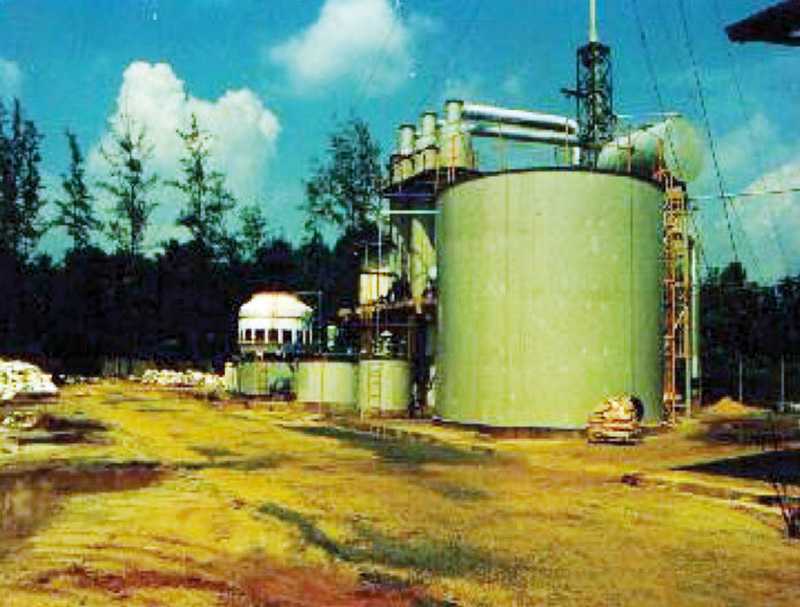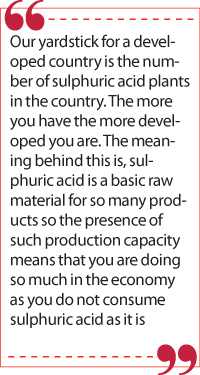Sunday Dec 15, 2024
Sunday Dec 15, 2024
Thursday, 10 December 2020 00:11 - - {{hitsCtrl.values.hits}}

Ranala sulphuric acid and alum plant – Sri Lanka had one acid plant at Ranala and amidst public protest we were very quick to rush to realise the demise of the facility instead of attending to any faults and ensuring continuity with the understanding of the value
 Agree or disagree? Ratings appear to come in thick and fast. Our own ratings have placed an alcoholic beverage at triple A (lka). Cheers! The country and the banks however appear to go in a reverse direction.
Agree or disagree? Ratings appear to come in thick and fast. Our own ratings have placed an alcoholic beverage at triple A (lka). Cheers! The country and the banks however appear to go in a reverse direction.
Believe in general that we are not at a crisis state, having passed a tipping point of no return. However, also believe that one should take serious note of the issues and address root causes rather than being happy with patchwork solutions.
One area of significant deficiency is in our manufacturing i.e., the real industry. Take away manufacturing and the economies are unlikely to grow and grow with confidence. We have dabbled with ‘grow to eat’ mindset but never really seriously for a competitive manufacturing position.
Conditions outside have changed dramatically while we languish with an economy in $ 80+ billion. We are well aware of the structural issues with the economy. The poor plight of our export basket is well known. State-Owned Enterprises engaged in manufacturing sectors exist in quite difficult conditions and when you see the resource platform that they have access to, you wonder why that should be in that situation at all. There is definitely a serious problem.
From another vantage point that is also a serious challenge and an opportunity. Moonshot thinking comes to one’s mind as the option from a leadership perspective as energising across a wider community is important for a favourable result at this juncture.
Moonshot thinking
The concept of moonshot thinking goes back to John F. Kennedy though he did not articulate the concept. It was what he stated and subsequently the nation achieved that led to the coining of the term.
“We choose to go to the moon. We choose to go to the moon in this decade and do the other things, not because they are easy, but because they are hard,” was what JFK stated in his 1962 speech at the Rice University.
The race to a moon landing was on and the State was mobilised. Impossible became possible. Such thinking is about pursing almost the impossible, but if done could completely redefine the situation. The need for moonshot thinking is that insinuates that a smaller goal and such an utterance is unlikely to inspire and arouse passion among masses. So audacious goals are a must and the statement has to be perfect!
We see an Operation Moonshot in UK. It is the UK Government’s newly-proposed COVID-19 mass testing scheme, which means 10 million tests per day. In parallel also you see the 1st approved vaccine being applied to a 90-year citizen. The vaccine development too proceeded with speed and the UK setting up a Vaccine Manufacturing Centre. Twin strategies to get back into the business as usual.
The science and the technology are there though the initial UK death rate became the worst death rate in Europe again as a result of trying to follow a wrong scientific path initially. The presence of science coupled to manufacturing is always a recipe for success. UK’s vaccination strategy too is present with millions of vaccines on order. The herd immunity is coming closer. 
COVID-19 and manufacturing
COVID-19 is asking us to value manufacturing and be competitive as manufacturing is not with closed borders. Sri Lanka has failed to pursue a path of industrialisation for quite a long time. Some industries were established but many were gifts from different countries.
In the early phase of industries during the British era that was more to do with facing the war. We had communities managing the ‘gifts’ for some time but the operations were declining over time and no upgrades or advanced technology infusions were never carried out. Decline was inevitable.
With many an SOE, the collection of assets as ageing stock is a fact. As technology advanced through R&D and innovation elsewhere, we were nursing sick units with time. As you read histories of certain factories, this situation is observed. Another aspect to a late developer is having to face a multitude of international agreements in these times and the consequent opportunity space becoming limited.
Sri Lanka over the years has seen import substitution policies; open economic policies with export orientation; looking at FDI-based growth and next reverting to protectionist policies. The policy incoherency can stress the industry structure for sure where the final result has been little advancement in realising a resilient diverse manufacturing base.
We find we bring lots of raw materials and then add value and push back to outside. With resources we have we are engaging in commodity trading almost. Innovation is seen in very few quarters. International market capture is again almost restricted to few of these innovators. With commodities we do not call shots. The concept of hi-tech manufacturing is absent and we have almost the least percentage of hi-tech sales based income as a percentage of manufactured exports in the region.
Though in 1989 Sri Lanka came up with the first industrialisation strategy with the Industrial Promotion Act following up in 1990, there was lot less anticipated industrialisation. Services contributed to the economy and the percentage was going over 50% of GDP and in many quarters services became the mantra for success.
COVID-19 has shattered the concept though there is very little open acknowledgement of the fact. Anyway the realisation of the value of manufacturing is beginning to surface. With WTO, TRIPS and many more, definitely the art of industrialisation has to be different. Yet I am sure some of the basics are not different.
Remember what late Eng. D.J. Wimalasurendra mentioned in his speech as a member of the State Council of Ceylon in 1932: “Besides, the experiments referred to by our learned fried, were not carried out by Ceylonese; they were carried out by European gentlemen who were perhaps not very keen to have the industry introduced into this country. Such an introduction would have meant that about 5,000 to 20,000 people in Europe would be thrown out of employment… I went over what is known as the ‘Sunken Country’ in England, where they manufacture, refine and export salt. We get our table salt from abroad, in spite of the fact that we have salt all round our coast! What we are really doing here is to retard the manufacture of salt in spite of having a highly paid salt adviser and a big staff. When we have cheap electricity, by the process of electrolysis, we will be able to manufacture soda, potash, bleaching powder, and so on, and other alkali necessary for the manufacture of soap and other chemical products.”
He was all about manufacturing. Today we are more concerned about the delivery of electricity to watch TV and soap operas.
Yardstick for a developed country
In our lectures in Chemical Engineering we remind our students that our yardstick for a developed country is the number of sulphuric acid plants in the country. The more you have the more developed you are.
The meaning behind this is, sulphuric acid is a basic raw material for so many products so the presence of such production capacity means that you are doing so much in the economy as you do not consume sulphuric acid as it is! In fact even from an international trading aspect sulphuric acid is the number one traded chemical, with ammonia today coming second.
With that logic Sri Lanka had one acid plant at Ranala and amidst public protest we were very quick to rush to realise the demise of the facility instead of attending to any faults and ensuring continuity with the understanding of the value. How many times have we seen the demise of plants of this nature? Urea plant comes to the mind here. Again understand why ammonia is the second most traded chemical in the world. At present with zero sulphuric acid factories in the country that means no way we can claim any status of development. From fertiliser, textiles to water treatment, this is a basic necessity and when you analyse the space Sri Lanka has no significant Chemical Process Industry (CPI) presence.
Singapore with its significant economic contribution coming from the manufacturing sector, you see the presence of a dynamic chemical industry and also they started their nation journey with CPI.
We still see a sectoral and a quite simplified interest taken when thinking about industry – quite a silo approach. However, in modern times the recommendation is to move for a more horizontal-driven industrial policy, ensuring competitiveness across the board. Definitely policies biased to import substitution are not in vogue today. The situation is challenging. Time is passing with each day, perhaps making the challenge even more challenging!
Mobilise resources to achieve transformation
Such times then demand moonshot thinking. There is a need to mobilise resources to achieve a transformation that for most of the times we considered as impossible. Perhaps the industrial policy must understand the potential of the knowledge economy. It must definitely value the presence of resources of diverse types as we certainly are not a resource-constrained society.
Yes that may be true in conventional sense but with emerging sciences the resource base we have has real potential. That indicates a direction for moonshot thinking. Transformation of the economy has to have the following and all can be delivered via a manufacturing led strategy.
Realising a per capita expenditure on food below 20% of the income, SOEs with resource bases to be resilient, manufacturing entities not standing alone but standing connected and extended to value chains, ocean resources creating a marine-based industry cluster, the nascent drive on nanotechnology and biotechnology to be challenged to contribute to 6% GDP, mission to ensure in a defined time period the exports overtaking imports not by controls but by value added, ICT to support the cyber physical connectivity to herald Industry 4.0!
Not ICT as the sole way of growth; challenging to realise 50% GDP through the manufacturing sector. Strategies are staring at us if the mindset switches to manufacturing but some rough and edgy riding has to be anticipated and that is the grittiness expected in moonshot thinking and doing!